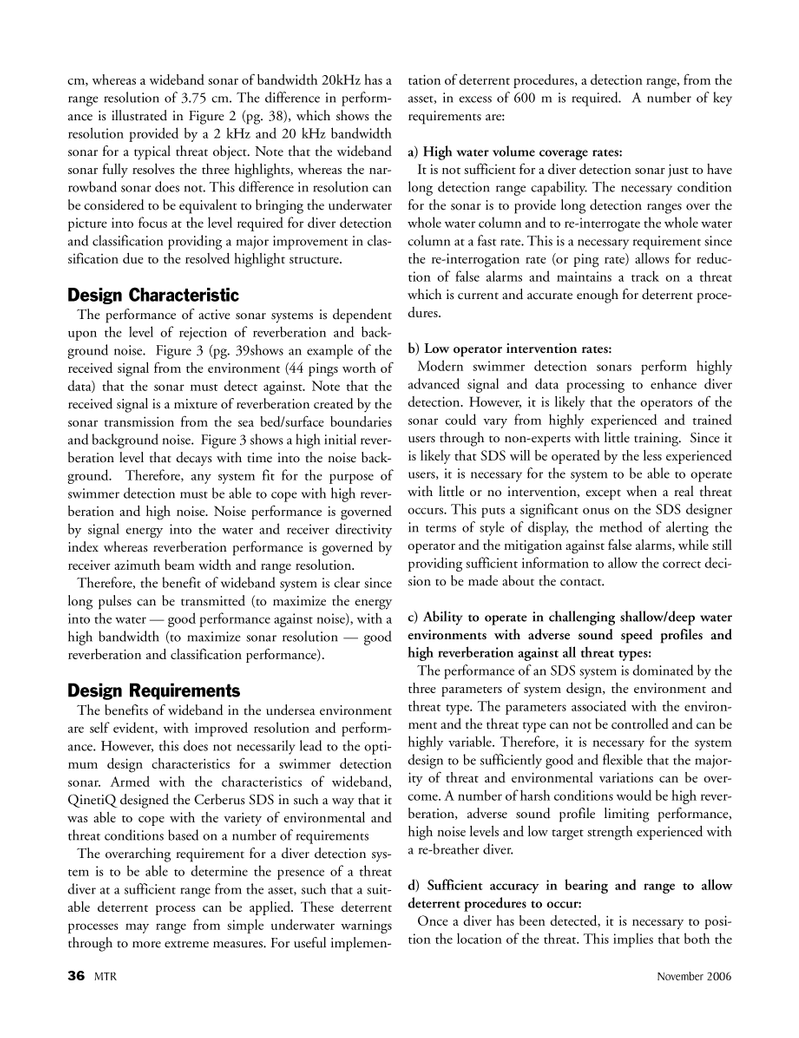
Page 36: of Marine Technology Magazine (November 2006)
Deep Ocean Exploration
Read this page in Pdf, Flash or Html5 edition of November 2006 Marine Technology Magazine
36 MTR November 2006 cm, whereas a wideband sonar of bandwidth 20kHz has a range resolution of 3.75 cm. The difference in perform- ance is illustrated in Figure 2 (pg. 38), which shows the resolution provided by a 2 kHz and 20 kHz bandwidth sonar for a typical threat object. Note that the wideband sonar fully resolves the three highlights, whereas the nar- rowband sonar does not. This difference in resolution can be considered to be equivalent to bringing the underwater picture into focus at the level required for diver detection and classification providing a major improvement in clas- sification due to the resolved highlight structure.
Design Characteristic
The performance of active sonar systems is dependent upon the level of rejection of reverberation and back- ground noise. Figure 3 (pg. 39shows an example of the received signal from the environment (44 pings worth of data) that the sonar must detect against. Note that the received signal is a mixture of reverberation created by the sonar transmission from the sea bed/surface boundaries and background noise. Figure 3 shows a high initial rever- beration level that decays with time into the noise back- ground. Therefore, any system fit for the purpose of swimmer detection must be able to cope with high rever- beration and high noise. Noise performance is governed by signal energy into the water and receiver directivity index whereas reverberation performance is governed by receiver azimuth beam width and range resolution.
Therefore, the benefit of wideband system is clear since long pulses can be transmitted (to maximize the energy into the water — good performance against noise), with a high bandwidth (to maximize sonar resolution — good reverberation and classification performance).
Design Requirements
The benefits of wideband in the undersea environment are self evident, with improved resolution and perform- ance. However, this does not necessarily lead to the opti- mum design characteristics for a swimmer detection sonar. Armed with the characteristics of wideband,
QinetiQ designed the Cerberus SDS in such a way that it was able to cope with the variety of environmental and threat conditions based on a number of requirements
The overarching requirement for a diver detection sys- tem is to be able to determine the presence of a threat diver at a sufficient range from the asset, such that a suit- able deterrent process can be applied. These deterrent processes may range from simple underwater warnings through to more extreme measures. For useful implemen- tation of deterrent procedures, a detection range, from the asset, in excess of 600 m is required. A number of key requirements are: a) High water volume coverage rates:
It is not sufficient for a diver detection sonar just to have long detection range capability. The necessary condition for the sonar is to provide long detection ranges over the whole water column and to re-interrogate the whole water column at a fast rate. This is a necessary requirement since the re-interrogation rate (or ping rate) allows for reduc- tion of false alarms and maintains a track on a threat which is current and accurate enough for deterrent proce- dures. b) Low operator intervention rates:
Modern swimmer detection sonars perform highly advanced signal and data processing to enhance diver detection. However, it is likely that the operators of the sonar could vary from highly experienced and trained users through to non-experts with little training. Since it is likely that SDS will be operated by the less experienced users, it is necessary for the system to be able to operate with little or no intervention, except when a real threat occurs. This puts a significant onus on the SDS designer in terms of style of display, the method of alerting the operator and the mitigation against false alarms, while still providing sufficient information to allow the correct deci- sion to be made about the contact. c) Ability to operate in challenging shallow/deep water environments with adverse sound speed profiles and high reverberation against all threat types:
The performance of an SDS system is dominated by the three parameters of system design, the environment and threat type. The parameters associated with the environ- ment and the threat type can not be controlled and can be highly variable. Therefore, it is necessary for the system design to be sufficiently good and flexible that the major- ity of threat and environmental variations can be over- come. A number of harsh conditions would be high rever- beration, adverse sound profile limiting performance, high noise levels and low target strength experienced with a re-breather diver. d) Sufficient accuracy in bearing and range to allow deterrent procedures to occur:
Once a diver has been detected, it is necessary to posi- tion the location of the threat. This implies that both the
MTR#9 (33-48).qxd 11/13/2006 4:36 PM Page 36

 35
35

 37
37
